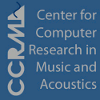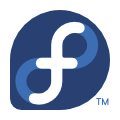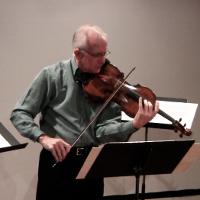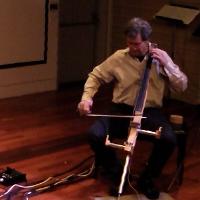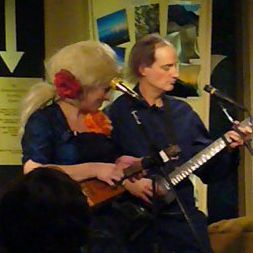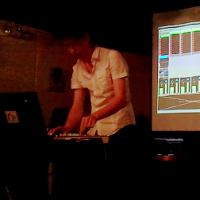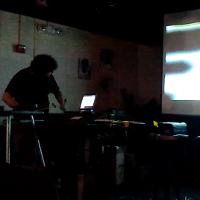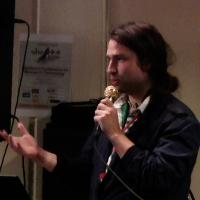There are evening concerts on the CCRMA stage the first three days of the conference starting 8pm.
Saturday night also features the Linux-Sound-Night; 10pm "CoHo" @ Tressider; a bar place near CCRMA, on campus.
Last but not least there is music and art that can be enjoyed in the "Listening Room" at CCRMA, every day of the conference during opening hours; except for Friday afternoon 3.45pm to 4:30pm when the "Listening Room" is closed for a workshop.
Day 1 - Thursday, April/12
8pm Traxpong Juan Reyes » Location: CCRMA Stage
TraxPong is a tape-music (mediatic) composition based on J.C. Risset's rhythmic paradoxes, applied to speech signals so that their effect is implicit. The source of these signals belongs to previous works, Las Meninas(1991) and TxRx Pong(2007). "Trax" means transmitting a source signal while "pong" is receiving feedback from the source signal, both terms used in radio transmission and appropriated in radio art. The effect of each rhythmic paradox is a continuous crescendi or otherwise decrescendi, to achieve tension contrasts throughout the piece. Other sounds in this piece are futher processed using spectral modeling, as well as known delay-line techniques. Spatial manipulation is achieved by distance changing trajectories of sound sources over Lissajous graphic schemes. This piece was composed using Bill Shottstaedt CLM and Snd, with Michael McNabb's reverb in addition to Juan Pampin's ATS on a PlanetCCRMA Linux workstation.
Day 1 - Thursday, April/12
8pm First Lament Of The Cello Machine Dave Phillips » Location: CCRMA Stage
A 5-minute piece composed with Csound (via Jean-Pierre Lemoine's AVSynthesis). Edited and mastered with Ardour3.
Day 1 - Thursday, April/12
8pm FT001 Martins Rokis » Location: CCRMA Stage
"FT001" is stereo version of multi channel recording made with Supercollider 3 programming language on Puredyne and edited in Audacity with aim to explore possible synergy between control/decontrol, merging generative strategies with improvised real-time decisions,creating dense, abstract sound gestures influenced by communication patterns of insects and birds. Resulting textures serves as background material for live coded responses or further manipulations and edits.
Day 1 - Thursday, April/12
8pm Mitslalim Oded Ben-Tal, Rees Archibald, Caroline Wilkins » Location: CCRMA Stage
Music - Oded Ben-Tal; Video - Rees Archibald; Performance - Caroline Wilkins;
The title is a play on the affinity, in Hebrew, between the word for sound (Tslil) and shadow (Tsel). If the word existed in the language it might mean 'sonorities of shadows'. The piece emerges out of Zaum: beyond mind – an ongoing collaboration between composer/performers Caroline Wilkins and Oded Ben-Tal. Zaum is a sound theatre piece particularly interested in the notions of embodied musical performance as it relates to the digital nature of much of the sonic material and the changing relationship between the different types of presence. A chance encounter with Rees in Caen led us to try and extend our collaboration.
Day 1 - Thursday, April/12
8pm Caladan Florian Hartlieb » Location: CCRMA Stage
Electroacoustic Audio-Fiction in three movements
1.Landing (3' 51")
2.Exploration (2' 40")
3.Encounter (5' 07")
At an unknown time,
in an undated year,
a no further defined species encounters an undiscovered planet
The piece Caladan is inspired by the Science-Fiction Novel 'Dune' by Frank Herbert. The piece is divided in three movements that shall take the audience on a fictive journey to a foreign planet.
The first movement describes the landing in the new world. Different sounds from crickets, doves and water (in the novel 'Dune', Caladan is the Water-Planet) are combined with synthetic sounds, generated through Frequency Modulation.
The second movement deals with the exploration of the unknown planet. High tension is created and the water sounds get very obvious in this part.
In the third movement, different kinds of being encounter themselves, which is musically described through question-answer gestures. The different sounds of the gestures seem to learn from each other and result in a merged soundworld.
Day 1 - Thursday, April/12
8pm Composition in Loops #1 Zachary Berkowitz » Location: CCRMA Stage
Composition in Loops #1 presents a performance interface with a tight integration between audio and visual elements created using Pd and GEM. This allows the performer to fluidly compose and perform within the audio-visual realm, and attempts to eliminate any disparity between the two elements. The included recording is a screencast of the live performance.
This is a piece of accidents, glitches, and mistakes. As in all art, this piece is a product of the feedback loop that occurs between the artist and their chosen medium. Sometimes, we are reduced to observing the medium's behavior and trying to intervene.
Day 2 - Friday the 13th
8pm Densité Benjamin O'Brien » Location: CCRMA Stage
"Densité" was written in the audio software languages of SuperCollider and Paul Koonce's PVC. "Densité" documents the interactions between the density of samples being selected and the dimensions of the space in which they are realized. Depending on particular sets of heuristics, different exponential models and soundscape audio files determine percussion sample playback parameters which are, in turn, recorded. These audio segments are then convolved with varying types of impulses responses, resulting in different sonic spaces. "Densité?" focuses on subverting the inherent sonic qualities of percussion instruments as a result of temporal sequence and their individual placement within particular spaces.
Day 2 - Friday the 13th
8pm fluid dynamics Adam Neal » Location: CCRMA Stage
In fluid dynamics, video and audio were both heavily processed to highlight and emulate the natural behaviors of water, oil, heat, and light.
Day 2 - Friday the 13th
8pm Metal Clouds Jan Jacob Hofmann » Location: CCRMA Stage
I made this piece in 2001 using Csound and 2nd order Ambisonic. It now got re-rendered for 3rd order and if performed, it will be the very first time the piece will be diffused as it was intended to: in full 3d (periphonic) with a lot of spatial resolution thanks to 3rd order Ambisonic and marvellous 22 speakers.
Day 2 - Friday the 13th
8pm Terra Incognita Frank Ekeberg » Location: CCRMA Stage
Terra Incognita is a journey to an "otherworldly" sonic landscape. It provides a setting which may evoke images of something real or fantastic that borders to the narrative. The work is composed in the ambisonics technique in order to create a three-dimensional sound-sphere in which sounds can move about in any direction, and where full surround-sound environments can be set up. The wide dynamics and the variations in range and speed of movement of the different sound materials in this piece indicate ever-changing situations, sometimes expected, other times not.
Day 2 - Friday the 13th
8pm Sol Aur Lawrence Fyfe » Location: CCRMA Stage
Sol Aur is an exploration of the use of FM synthesis. It also serves as a vehicle for the Orrerator control interface.
The Orrerator a software controller built for Android tablets. Sound for Sol Aur is generated by four FM oscillators in Pd, with each oscillator being detuned from a base frequency. By changing the tuning, the index of modulation, and the modulation frequency, many combinations of FM sounds can be created and shifted over the course of the piece.
Day 2 - Friday the 13th
8pm Rick's Trombone Christiane Strothmann » Location: CCRMA Stage
If the Trombone was a city, - how would it sound like?
A piece made of trombone sounds transformed into concrete and atmospheric city-like sounds. A soundwalk through an imaginary city that tells also about the inaudible and emotional events that have taken oder will take place within it.
Trombone sounds taken from and worked out with the trombonist Rick Peperkamp (NL).
All sounds are taken from an experimental session with Rick Peperkamp. Afterwards Strothmann transformed the recorded sounds (including some snippets of spech) in the following way:
She wrote a personal algorithm in *scheme* by which she was able to determine the harmonic and rhythmic microstructure of the sounds which were to be proceeded with *csound*. The scheme-code generated the csound-scores of the two csound-instruments used for the sound proceeding within "Rick`s Trombone".
Day 3 - Saturday, April/14
8pm Vespers Dave Phillips » Location: CCRMA Stage
A brief piece created with the Csound resources of AVSynthesis, an audio/visual composition/performance environment.
Day 3 - Saturday, April/14
8pm Digital RoundO #1 Lorenzo Franco Sutton » Location: CCRMA Stage
Digital RoundO #1 is a homage to music pioneers of the past. A reflection on the past which tries not to be nostalgic but hopefully provide an insight on the present and future of music. Here I have been looking at the remote past of Baroque Music masters in the piece's title, form and eloquent gestures. The more recent past of electronic music pioneers in its sound synthesis techniques and the craft work of assembling them and the creative use of effects. Use of minimal raw audio materials went in such direction. Finally, Digital RoundO #1 is a 'dance' which aims to provide listeners with an intriguing sonic experience.
Digital RoundO #1 was entirely composed on Linux. The raw materials are essentially additive synthesis produced in two ways: 1. An additive synthesiser I created in Pure Data which is driven by Markov chains. 2. Analysis and Resynthesis of bitmap images through the ARSS software written by Michel Rouzic. After creating an initial 'palette' of interesting raw sounds I solely used Ardour as my workbench with chisel-work montage and layering, working on panning and enveloping to shape the overall form of the piece. A Stereo Reverb effect (by Fons Adriansen – LADSPA version) was used in a very creative, unorthodox way through the continuous variation of the Reverb Tail parameter.
Day 3 - Saturday, April/14
8pm Birches for viola and electronic sounds Kevin Ernste » Location: CCRMA Stage
Birches was composed as a response to the poem of the same title by the great American poet, Robert Frost. My intent was not to "set" the poem, but rather to explore its inner workings -- to re-imagine its parentheticals, present in Frost's vicarious vision of a boy, a scene of birches, and the truth of the matter versus the `truth' as revealed in the confession of an old man looking back.
Birches is dedicated to my father and was composed for violist John Graham.
Open Source tools:
The electronic part for Birches is derived entirely from Mr. Graham's own instrument, an Amati viola with a rather historic lineage. Software used to construct the electronic part includes Csound, Score11 (a Csound even preprocessor), Xavier Serra's SMS (Spectral Modeling Synthesis, on an SGI O2 workstation), Paul Koonce's PVC, the Ardour DAW, and several open source sound file editors including Wavesurfer, Snd, and DAP.
Performance:
Live performance is enabled by a PD patch. Playback is from stereo master files which can be diffused as multichannel.
Day 3 - Saturday, April/14
8pm Rite of the Earth Krzysztof Gawlas » Location: CCRMA Stage
Rite of the Earth is a series of pieces utilizing sounds of ceramic instruments built during the Academy of the Sounds of the Earth, a
multidisciplinary artistic project held in the Artistic Department of Silesian University in Katowice (Poland). Most of the compositional process and sound synthesis was carried out in SuperCollider, mixing and spatializing in Ardour, with the use of tools by Fons Adriaensen. In this sixth part, there's an orchestra of bowed bowls, flutes, ocarinas, shakers and drums, all brought to life by various computer music techniques.
Day 3 - Saturday, April/14
8pm Vocal Etude (audiovisual version) Nicola Monopoli » Location: CCRMA Stage
Description of "Vocal Etude"
It is a piece composed by Nicola Monopoli.
Vocal Etude is an etude on the voice which is probably the
best instrument of the world.
The voice could be the voice of a child, the voice of a girl,
the voice of the people we hear every day or also the inner
voice.
This etude is a "Ricercare" on the voice.
Day 3 - Saturday, April/14
8pm Princesa Chontales Chris Chafe, Roberto Morales » Location: CCRMA Stage
Morales composed the computer sequences and processing effects after
his experiences recording music of the Huaves natives of Oaxaca, Mexico.
His work at The Banff Centre in March, 2009 included this performance
with Chris Chafe.
Day 3 - Saturday, April/14
10pm Debb and Duff play the music you ate your first crawdad by Miller Puckette, Juliana Snapper » Location: CoHo (Stanford Coffee House)
A normal-looking country music duo, dressed a la Nashville and
brandishing a guitar, an autoharp, and a wooden cooking spoon, perform
new, sometimes ironic versions of old-timey tunes. What comes out of
the speakers is only partly identifiable as the instruments and voices
of the musicians. Their 20-minute set combines standards (Dolly Parton;
Johnny Cash) with more obscure fare, all transformed using experimental
signal processing algorithms implemented in Pd on linux.
Day 3 - Saturday, April/14
10pm Luppp & Harry Harry van Haaren » Location: CoHo (Stanford Coffee House)
Live performance of Luppp & Harry on stage, with some loops being loaded from disk, some live parameter twiddling, some live noises being made and looped.
No particular "routine" will be practiced, it will be a live improve on the day, with some pre-made loops & melodies.
Day 3 - Saturday, April/14
10pm Cancelled: CIA-X Audio Unit Romain Papion, Julien Ottavi » Location: CoHo (Stanford Coffee House)
CIA-X is a new band coming from APO33 collective. For this time the two representants of the crew for the Linux Sound Night are Romain Papion aka Cambia and Julien Ottavi aka Jokiller.
This project is an evolution of underground Hip Hop with the influences of experimental music. All original instrumentals are created with libre software like ardour, Puredata, LMMS and lead with the voices of the mc's, mixing french and english lyrics, stories and abstract poetry.
Day 3 - Saturday, April/14
10pm Compositions in Loops nos. 1 and 2 Zachary Berkowitz » Location: CoHo (Stanford Coffee House)
Compositions in Loops nos. 1 and 2 present a performance interface with a tight integration between audio and visual elements created using the open-source software Pure Data and GEM. This allows the performer to fluidly compose and perform within the audio-visual realm, and attempts to eliminate any disparity between the two elements.
These are pieces born of accidents, glitches, and mistakes. As in all art, these works are a product of the feedback loop that occurs between the artist and their chosen medium. Sometimes, we are reduced to observing the medium's behavior and trying to intervene.
Day 3 - Saturday, April/14
10pm Secret Chiptunes and Time Explorations from a Bedroom Grant Centauri » Location: CoHo (Stanford Coffee House)
This was a last minute set put together for Linux Sound Night, as
another performer dropped out. The first set of music is all from a
video game that was never made. The tunes were composed with
Nitrotracker on the Nintendo DS, a nice example of free software
opening up closed hardware and making it do something that was never
intended. The last two pieces are granular explorations of the same
Beach Boys song, one with lyrics written specifically for this
performance.
Installation/Loops
Day 1 - Thursday, April/12
10am The Invisible Suns Project(4 min - loop)
Marco Donnarumma » Location: Listening Room
Invisible Suns (Marco Donnarumma, 2010-2011) is an autonomous system that perform a permanent analysis of historical stock prices of a variable selection of major corporations, compresses in few minutes over 10 years of economic transactions and eventually produces a generative and self-organizing audiovisual datascape every 24 hours.
The work does not focus on traditional visualization of data, but rather aims at exploring how this data -- and their implied meaning -- can be perceptually, emotionally experienced.
Everyday since the 1st August 2010 the system retrieves from the Internet up to date stock prices of selected companies and adds new values to its set of databases. The oldest figures date back to January 2002 while the newest are being collected today. At the moment the system is analyzing historical stock prices of six companies which boast the highest market capital in defense and oil industry: BAE Systems, Lockheed Martin Corporation, Exxon Mobil Corporation, Royal Dutch Shell, Chevron Corporation and General Dynamics Corporation.
Data are processed in real time to generate a panoramic, synaesthetic scape which demonstrates an auditive sensation of expansions and falls of companies shares as well as the overall movement of the trading market.
The system also operates a cross-comparison of datasets in order to identify peaks and lows in the overall trading activity and outline them utilizing sound spatialization and lights movements in the 3D environment.
Duration of the work, intended as audio visual output, is constantly growing: as figures increase every day, the time length of the piece increments too.
Day 2 - Friday the 13th
10am Warscape Sonata(4 min - loop)
vlax v0x » Location: Listening Room
Warscape Sonata is a sound installation that streams sonic information related to the current drug war in Mexico. RSS news channels, microblogging hashtags, and viral videos are used as sources for an electronic registry of the historic moment of militarized Mexico. The information obtained from these sources is manipulated by software to extract sound archives which are then used to create a noise musical structure that places aesthetic emphasis on the media aspect of the war. Warscape Sonata also highlights the way in which Mexico's civilian population experiments with information technologies to confront propaganda, social control and fear. This is an on-site project for the CCRMA's Listening Room: it will stream randomly 3 different playlist from around, above and below to create a 22 channel sonic experience.
Recording Studio run completely on Linux. Jason Jones » Location: Listening Room
A mix of music produced at advancedbudgetstudios.com entirely on Linux.
I use Mixbus and LinuxDSP plugins (as well as a lot of OSS plugins) to track, edit, mix, and master my clients' audio.
La forge de Vulcain Olivier Baudouin » Location: Listening Room
This electroacoustic work, entirely generated by sound synthesis with Csound*, is based on an original system that emphasizes harmonics of sound. A sound wave with deep metallic sheen slowly unfolds his plot and gradually undergoes subtle variations or radical. Sometimes volcanic or stormy, the sonic material forged by Vulcan here evokes the heat, power and stability of terrestrial bowels.
* V. 5.14 compiled for Fedora 14, and played with the PlanetCCRMA RT kernel.
Structures Augusto Meijer » Location: Listening Room
"Structures" is the result of a research composition project, exploring the creation of complex structures into sound, which are developed into a large number of varieties. The goal is to achieve an improvement in the process of sound creation for acousmatic works. This research project is a major part of a personal study in electro-acoustic composition, at the Utrecht School of the Arts, the Netherlands.
Hacia la Expansión auditiva constante Federico Barabino » Location: Listening Room
Series of sound compositions where the relationship between recorded music andconcert halls are exploring the field itself. Inspired by the forms of visual artists in generalcreate their works inside their studios and then exposed them, compose a work of thesefeatures per year. Then I present it in various festivals and concours where the work is completed by itself, without my physical presence. Could be understood, then this series of compositions as a continuous evolution of asimple idea, listen.
"Hacia la Expansión Auditiva Constante" (6' 29")
Inspired by the micro universe of sounds with which we live all the time, "hacia la expansión auditiva constante" offers an approach to sound generated by the electricity itself.
Based on the "error" of the console itself, connecting cables to input and output without adding any external instrument, are born all the variables that are then processed byseveral different effects and compositing techniques to shape the final work.
A profound hearing away from anxiety, a search of total dispossession, a path towards the essence of sound itself ... then can we enjoy the music that surrounds us all the time?
Juicy Joyce - Subvocalizing (at pre-speech level) Nicola Monopoli » Location: Listening Room
Subvocalization, or silent speech, is defined as the internal speech made when reading a word, thus allowing the reader to imagine the sound of the word as it is read. Is possible to associate subvocalization with moving one's lips, but most subvocalization is undetectable even by the person doing the subvocalizing.
Subvocalization usually occurs during the stream of consciousness.
According to Chomsky's theories about a `universal grammar' is possible to say that there are things that have the same meaning for every human. These things are before the word, just like subvocalization.
When I showed this work in various concerts people usually received the same message, the same impression, the same meaning from this quite `abstract' multimedia piece, maybe it is connected to a universal idea, before the words.
The piece is divided into two movements.
Andante Sostenuto is `the road to the stream of consciousness'.
Con Fuoco -- Presto Agitato is the second movement. Con Fuoco is the inner monologue during the stream of consciousness and the final part, Presto Agitato, is the Epiphany, a moment of spiritual revelation.
This piece deals with a very primitive, pre-speech, level.
The sinæsizer - Insomnia Exomène » Location: Listening Room
Synesthesia is an ability of the brain of melting the senses together. Kandisky, who could hear music in colours or Nabokov, for which letters would conjure up colours were synesthetes. Synesthesia does not apply to the human brain only, as a symbol system the computer can produce synæsthetic experiences. The synæsizer is an artificial (multimodal and bidirectional) synesthete, its senses having been melt together by the use of data-bending. Its video system is directly plugged into the audio and vice-versa. If we compare it to a human being, it can hear with its eyes and see with its ears. But that quality of being a synesthete is only the consequence of its primary function, which is to generate a synesthetic experience on its user.
Claroscuros Oscar Pablo Di Liscia » Location: Listening Room
This composition is a, non-real time, entirely electronic piece (CA. 17.5 minutes) to be played without interruption between its four parts.
This electronic composition was entirely created using the GNU Csound program (By Barry Vercoe et al, MIT). Electronic sounds are produced by means of several Synthesis and processing techniques. The only exception of this are the voices which recite the poems and several minor audio files used as source to be processed by Csound. All the Csound code used (in its unified format, namely csd) is provided together with the mentioned audio files plus a Linux script (or a batch file, for Windows users) which execute them (using the Csound Command line) to make the work entirely from scratch. Needless to say, the user must have an updated Csound Version properly installed in his system. The last version of the work was successfully made using the Csound version 5.13 (double samples) Feb 11 2011.
This work, originally for 3D surround sound and lights, is the first part of a larger one that was commissioned by the National Secretary of Culture of Argentina and conceived to be performed in the reading room of the old National Library.
By one hand, the work presents the argentine poetry in its environment. By other hand, all the selected poems deals with the night from different perspectives as are the sunset, insomnia, wakefulness, dream, nightmares, and dawn.
The title (clair-obscures) sets a double reference: by one hand, the zones between the light and its absence which make the form arises (the chiaroscuro technique of the Italian painters leaded by Caravaggio). By the other, the multiple instances arising between the reference, the form and the sonority which are the essence of poetry and that electro-acoustic music may recreate with an intensity and precision without precedent in sonic art.
CREATION/DESTRUCTION Jason Sadural » Location: Listening Room
This piece has two parts, the creation of the bomb, and the execution of the bomb. It was 95 percent composed in Linux and uses samples, synthesis, and reverb techniques to give spatial effects.
Diptiq Benjamin O'Brien » Location: Listening Room
"Diptiq"
for computer playback
"Diptiq" is a documented solo improvisation with instruments written in the computer music language SuperCollider. The audio output signal of a variety of synthesizers is directed to specific audio busses to be read and shared by selected synthesizers. While these selections are unique to the human performer's musical aesthetic, the fluctuating frequency and amplitude values influence synthesis parameters, creating sonic instability. "Diptiq" explores how the unpredictability of common audio signals combined with human intention can yield moments of chaos and cohesion.
Aphelion Conor Curran » Location: Listening Room
Aphelion is the combination of the first two tracks from the Sonnamble album 'Blindlight' which was released on Forwind in July 2011.
Aphelion (a word meaning the point in a planet's orbit where it is furthest from the sun) showcases Sonnamble's dissonant while at the same time consonant approach to improvised minimalist soundscapes.
Dificilis Exitus Luis Valdivia » Location: Listening Room
8 Channels piece made with SuperCollider on Fedora 15.
Building & Something Jan Jacob Hofmann » Location: Listening Room
I made this piece in 2001 using Csound and 2nd order Ambisonic. It now got re-rendered for 3rd order and if performed, it will be the very first time the piece will be diffused as it was intended to: in full 3d (periphonic) with a lot of spatial resolution thanks to 3rd order Ambisonic and marvellous 22 speakers.
Grain Sailing Grant Centauri » Location: Listening Room
This piece is part of an exploration of
time using granular synthesis.
A moment of inspiration and emotion lead
to the creation of the original source,
and granular techniques were used to
revisit that moment and expand it, thus
exploring the many facets of its texture
and sonic palette. I've been fascinated
with the possibilities of exploring time
by changing the scale of perception.
Small moments of musical or sonic material
can be used as a palette for painting
a new experience composed of shifting
micro-sonic windows of time. There are
five sections to this piece which each
have different arrangements of sonic
grains coming from one source. Three of
them reflect closely the original source
and the other two are more focused on
the nature of microsounds.
17C Foam Rubber and Fur Steve Batte » Location: Listening Room
"17C Foam Rubber and Fur" uses several compositional techniques "popularized" by Elliott Carter, such as
* Metric Modulation -- the gradual introduction of a new tempo that is a division of the existing tempo
* All-interval 12-tone rows -- a static octave placement of all 12 notes in such a way that all 11 possible intervals exist between them
* Differentiation of voices by assigning each voice a subset of the 11 possible intervals
I've been exploring the advantages and limitations of these techniques, and have found that audio/midi apps are a bit better able to suffer some of the performance difficulties involved (though I've never seen a musician experience a segmentation fault). In this particular piece, I've attempted to make the above techniques somewhat obvious, and the music more accessible than Mr. Carter's tend to be. But maybe I'm fooling myself.
Soñando Satelites Luca Carrubba » Location: Studio D
Soñando Satelites [Dreaming Satellites] is a real time satellite sound installation that invites to dream and proposes to look over our head as a land to explore and hack.
It is a ritual of re-appropriation, a celebration of the fact we are involved in the same data-space that could control bodies or change relations between entities.
Soñando Satelites is a generative sound track connected to a real time multi tracking satellite system called Gpredict, especially patched for the installation. The installation aims to create an immersive audio/visual space for the audience: the public enters a dark room where a projection of a satellite real time tracking system is displayed.
The schedule is a major guideline. There is no guarantee events will take place at the announced timeslot.
